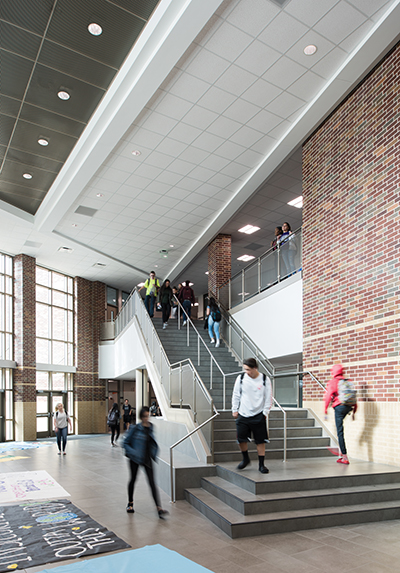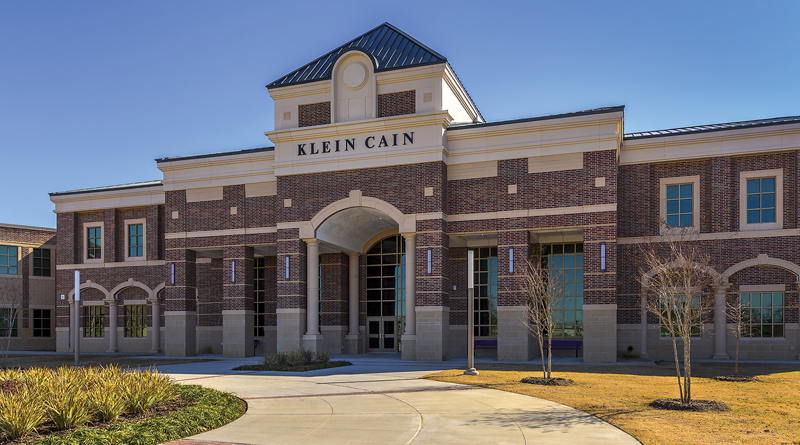Facility of the Month: Focusing on Flexibility
By Jessie Fetterling
Klein Cain High School, which made its debut in Houston last August, was long in the making.
Its story begins in 2008 when the Klein Independent School District realized it needed a new 9-12 high school (its fifth) to address the demographic growth within the community. At that time, the district did a selection process through a design competition that was won by locally headquartered PBK Architects. But then the recession hit, demographic growth plateaued and the project was shelved until 2012.
While oftentimes pausing a major project like this can pose a challenge, this time it worked out in the school district’s favor, according to Ian Powell, partner with PBK Architects. During that time, a major shift in the ways teaching and learning occurred was happening, as schools moved away from instructional-based learning to more independent learning methods that require more flexible, open spaces.
The project came to fruition in February 2015 when construction broke ground, with locally based Satterfield & Pontikes Construction Inc. serving as the construction manager at-risk. The result: A school that combines flexibility and transparency for next-generation learning while simultaneously addressing school security needs and prepping the complex for natural disasters just like Hurricane Harvey that hit five days after its opening.
Collaboration Is Key
One of the district’s criteria in the original design competition was to create a facility that reflected the heritage of the community, paying homage to the German immigrants who settled here in the mid-1850s. As such, the exterior of the building reflects traditional German architecture, with the steeply pitched gable metal roof at the entry, the subdivided exterior window configuration, the patterning of exterior brick masonry and the use of cast stone, according to Powell.
While that exterior element stayed the same between the 2008 and 2012 timeframe, the district wanted to do something completely different with the interiors when the project was greenlit again in 2012. “The district staff decided to make the inside much more transparent, open, collaborative and connected,” Powell said. “The school building is divided into six smaller learning communities (SLCs) that each have more transparency to classrooms and more openness.”
Each of the SLCs consist of about 20 to 24 classrooms, two collaboration spaces, a decentralized administrative/counseling suite and other support spaces, according to Powell. Classrooms are grouped around a larger open space that is centrally located within each SLC, and a linear, flexible space for smaller groups is located at the end of each SLC adjacent a circulation path. These spaces provide opportunity for teacher-dependent and independent activities, and are equally beneficial for study and project-based activities that foster interaction and collaborative efforts within student teams.

The design of the classrooms equally takes on a more collaborative approach using an L-shaped layout. “One of the concepts that the Klein administrators wanted to break the mold of was the traditional classroom, by changing the ‘box’ to more of an L-shaped classroom so that there are different zones in the classroom,” Powell said. “Teacher-dependent and teacher-independent instruction can occur as well as differentiated instruction (that involves all different kinds of instruction, not just the degrees of teacher dependency).”
That means students can use the space however they see fit, whether that be working collaboratively in groups, with or without a teacher’s participation, or working independently. Moveable glass partitions open up into the adjacent collaboration spaces for even greater flexibility. The majority of classrooms feature exterior windows that bring natural daylight into the space, while every classroom includes high transom windows that look onto adjacent circulation spaces. Both uses of windows help reduce the need for artificial lighting.
The high school teaching staff was a product of this environment, according to Powell. In fact, the school selected teaching staff that could accommodate the varying types of instructional settings, addressing any initial concerns as to if this classroom type and style would fit the nature of the individuals doing the instruction.
“They even did a post-occupancy survey, and greater than 75 percent were more pleased with this instructional space than the previous box-shaped space they had been in before,” Powell said.
Yet another example of the open design is the Learning Commons (or modern-day library), with a majority of its front being transparent and even having front walls that open up into the main corridor, dubbed “Main Street,” according to Powell. High ceilings and varied lighting adds to the open feel. And even private group study areas, such as the Think Tank, are lined with glass walls for better transparency.
Because the school district is very familiar with using data in decision-making, the design team surveyed both students and teachers at the four other high schools in the district early on in the design process. “They reinforced the choice to be intentional with the [design elements], including the transparency, openness, configuration of the classrooms, natural light in most of the classrooms and even the fronting of the Learning Commons right off the main circulation corridor,” Powell said. “All of these were thoughts we had, but the feedback we got was positive from both teachers and students.”
Of course, security was also top of mind for the new school. The main entrance features a safety vestibule, which has hardware that locks down if or when there is some form of a human threat. The school also has surveillance. While school district administrators are invested in designing schools that are more open and inviting, they have some provisioning related to safety and security that balances the need for the entrance to feel warm and open but also be able to be zoned off at the event of an emergency, according to Powell. He added that he can’t share some of those provisions to ensure the security strategies at the school remain confidential.
To read the entire article, check out the May/June issue of School Construction News.

